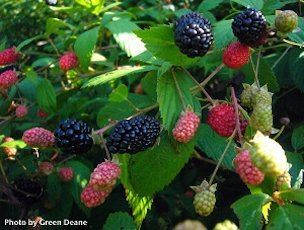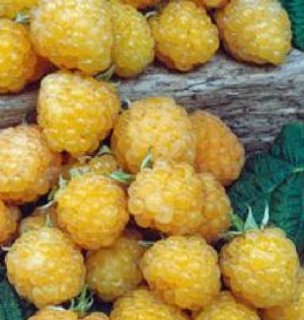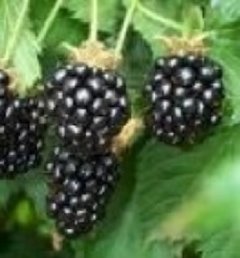From Eat the Weeds
and Other Things Too website
by Green Deane
Blackberries, A
Forager’s Companion

The center core remains when blackberries are picked making them
slightly bitter.
Blackberries:
Robust Rubus, Food & Weed
Anyone who forages will eventually collect blackberries and blackberry
scratches. These aggregate fruit are among the best-known berries in
North American, if not the world.
As a kid I can remember collecting wild raspberries long before wild
blackberries, though I don’t know why. Blackberries are standard
foraging fair (see my article about Dewberries. www.eattheweeds.com/have-dewberry-will-travel/)
What most people don’t know is that blackberries are a two-year plant,
some say three years. The first year it sends up a tall cane, replete
with thorns. The next year it flowers and has blackberries then dies.
Some would add that the cane stays on another year and with its thorns
to protect the patch. (I should add though that there are some
naturally thornless blackberries.)

Ripe blackberries can be yellow or red but usually they are black.
Blackberry leaves were in the official U.S. pharmacopoeia for a long
time treating digestive problems, particularly diarrhea. Their dried
leaves make an excellent tea even when you’re healthy. We presume
blackberries have been eaten for thousands of years by native American
Indians and used medicinally. The ancient Greeks considered the species
good for ailments of the mouth and throat and for treating gout.
Interestingly blackberries were found in the stomach content the
Haraldskaer Woman, an iron age bog body found in Denmark in 1835 but
killed around 500 BC. Her last meal was millet and blackberries.
Scholars think her death was probably a religious ritual. The millet
would have been standard Iron Age fare. Maybe the blackberries were a
special treat. Those blackberries would have also put her execution in
early summer, perhaps to ensure a good fall harvest by appeasing an
agricultural god.
For all their antioxidants and vitamins blackberries will mold within a
couple of days of picking if not refrigerated. Do not wash until time
of use because that, too, promotes mold. They ripen around June in the
south, July in the north, give or take a few weeks. Locally they can be
ripe by early May or totally past season by the Fourth of July. Picked
unripe berries will not ripen. Black berries are also a good source of
potassium, phosphorus, iron, and calcium. The seeds have Omega 3 and 6
fatty acids.
Insects and wildlife like the blackberry as well. This includes
honeybees, bumblebees, Little Carpenter bees, Nomadine Cuckoo bees,
Mason bees, Green Metallic bees (my favorite) flies, wasps, small to
medium-sized butterflies, skippers, hairstreaks, and several species of
moths. Fowl like the berries such as the Greater Prairie Chicken, Wild
Turkey, Bobwhite, Ring-Necked Pheasant, and various mammals from the
bear to rabbit. In fact I recently saw a rabbit nibble on blackberry
along a local bike trail.

In the rose family, just how many species of blackberries there are is
anyone’s educated or non-educated guess. Some argue a few species with
a lot of varieties and others argue for 250 or so species. Generally,
ones that crawl are in one group and those that form canes are in
another group. Then there are numerous unintentional and intentional
hybrids, such as the Loganberry, Youngberry and the Boysenberry. Even
the raspberry is a Rubus.
The name, Rubus
(ROU-bus) is the Dead Latin name for the blackberry and it means red
hair. There are several native local species. R. argutus, R. cuneifolius, R.
flagellaris and
R. trivialis (see the above Dewberry entry.) The ones I
harvest annually I think are escaped cultivars in that they produce
large, sweet berries consistently year to year.
Russia grows most of the world’s commercial blackberries, some 24
percent. Next is Serbia and Montegegro at 23%, the United States with
13%, Poland 11% and Germany 7 percent. Blackberries are native to every
continent except Australia and Antarctica. However, in Tasmania and
Australia the species are officially noxious weeds. Think about that:
an edible plant on the noxious list. Must not be too hungry in those
countries. In 2003 the Blackberry, Rubus
occidentalis, became the official fruit of Alabama.
Lastly there is one interesting note about aggregate fruit. At least
one expert says 99.99 percent of aggregate fruit are edible (such as
blackberries, mulberries, logan berries et cetera.) Personally I would
have liked to have seen listed the non-edible .01 percent.
Green Deane’s
“Itemized” Plant Profile
Identification:
A woody shrub with canes that grow up but often bend over sometimes
re-rooting. The canes grow the first year and fruits during the second
year, then they die. Canes are 3-6′ tall; green at the growing tip,
elsewhere brown or reddish brown with stiff prickles, straight or
slightly curved. Can be one inch through at the base. Leaves alternate,
usually trifoliate or palmately compound; long petioles. Leaflets up to
4″ long and 3″ across; can be twice as long as wide. Leaflet is usually
oval with coarse, doubly serrate edges; may have scattered white hairs
on the upper surface, lower surface light green and
hairy. Flowers, to an inch across, have 5 white petals and 5 green
sepals with
pointed tips; petals longer than sepals, rather rounded, often wrinkly.
Numerous stamens with yellow anthers. Blooms late spring to early
summer for a month; little or no fragrance. Drupes, actually aggregate
fruit, develop later in the summer; 3/4” long and 1/3″
across,size varies with moisture levels. Berries at first white or
green eventually turn red then black. Seedy, sweet.
Time of year:
Depending on climate, spring to late summer.
Environment:
Full sun, neither too wet or too dry, mesic conditions.
Method of
preparation: Numerous: fresh, frozen, canned, used for
wine, making ice cream, juice, pies, jelly, jam, and best of all when
eaten fresh on the trail. Dry leaves can be used for tea.
Leaves can be dried as is or fermented which improves the flavor
significantly. Fermented or not they should be dried. Young shoots can
be peeled and boiled in one or more changes of water. Running the fresh
leaves through the rollers of a pasta machine is a good way to crush
them for fermentation.
Green Deane's
Disclaimer
Information
contained on this website is strictly and categorically intended as a
reference to be used in conjunction with experts in your area. Foraging
should never begin without the guidance and approval of a local plant
specialist. The providers of this website accept no liability for the
use or misuse of information contained in this website.
Back to
Blackberry Page
|
|



